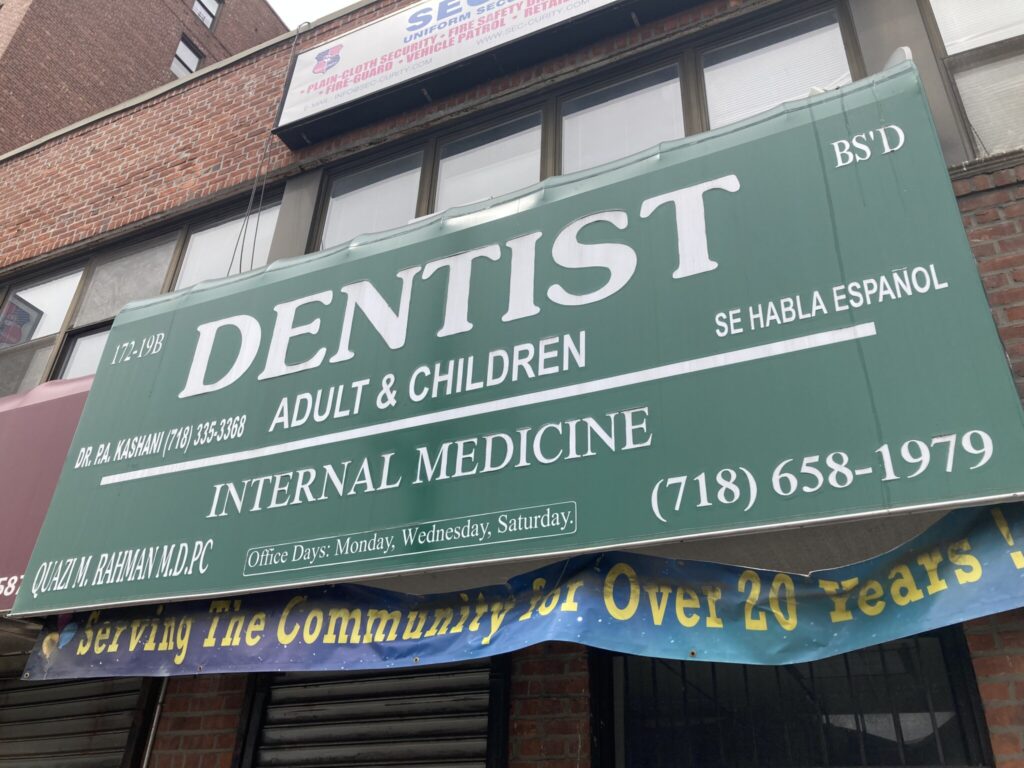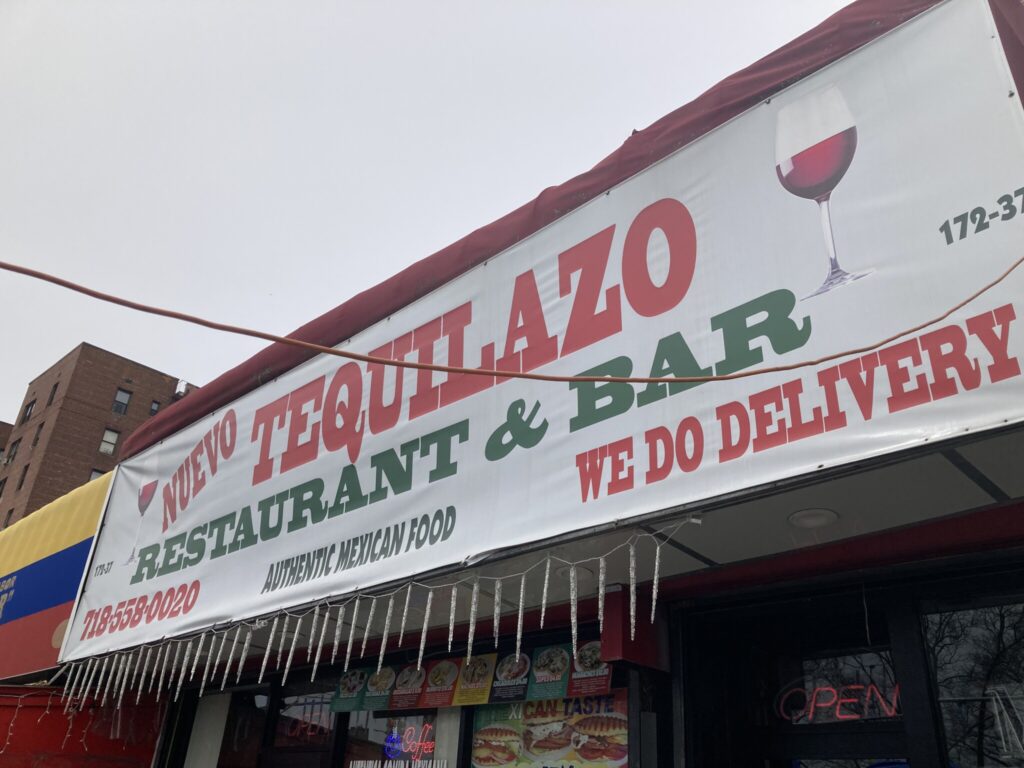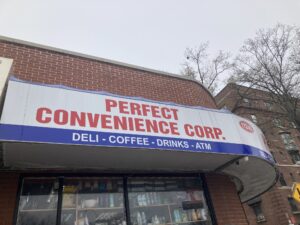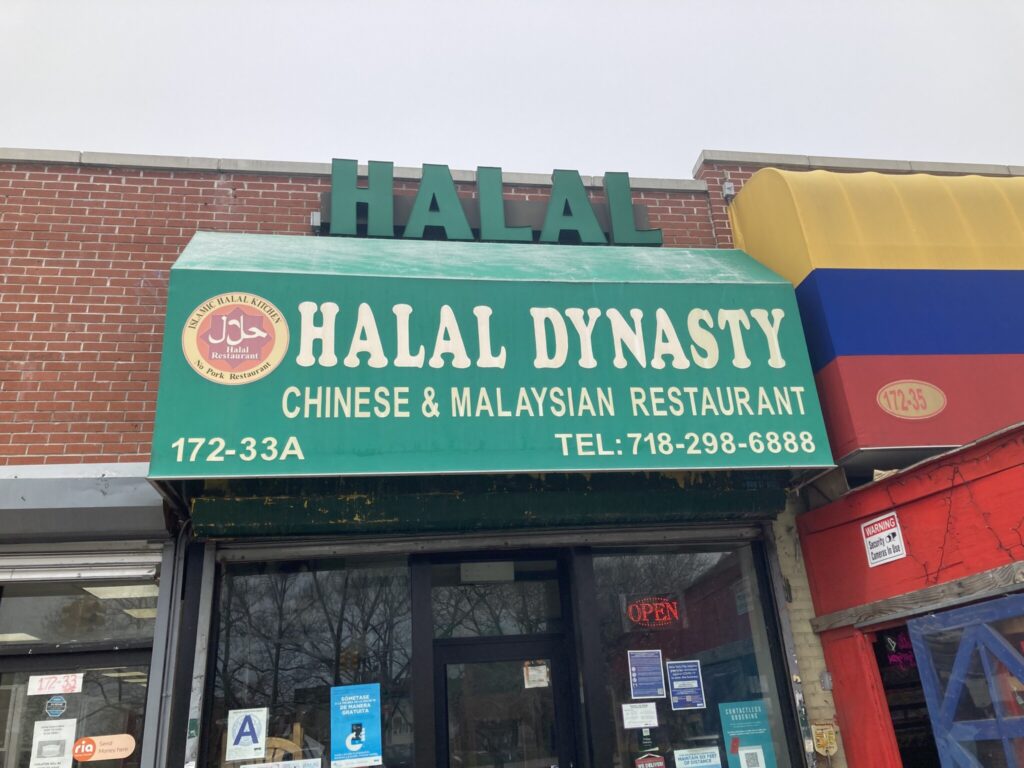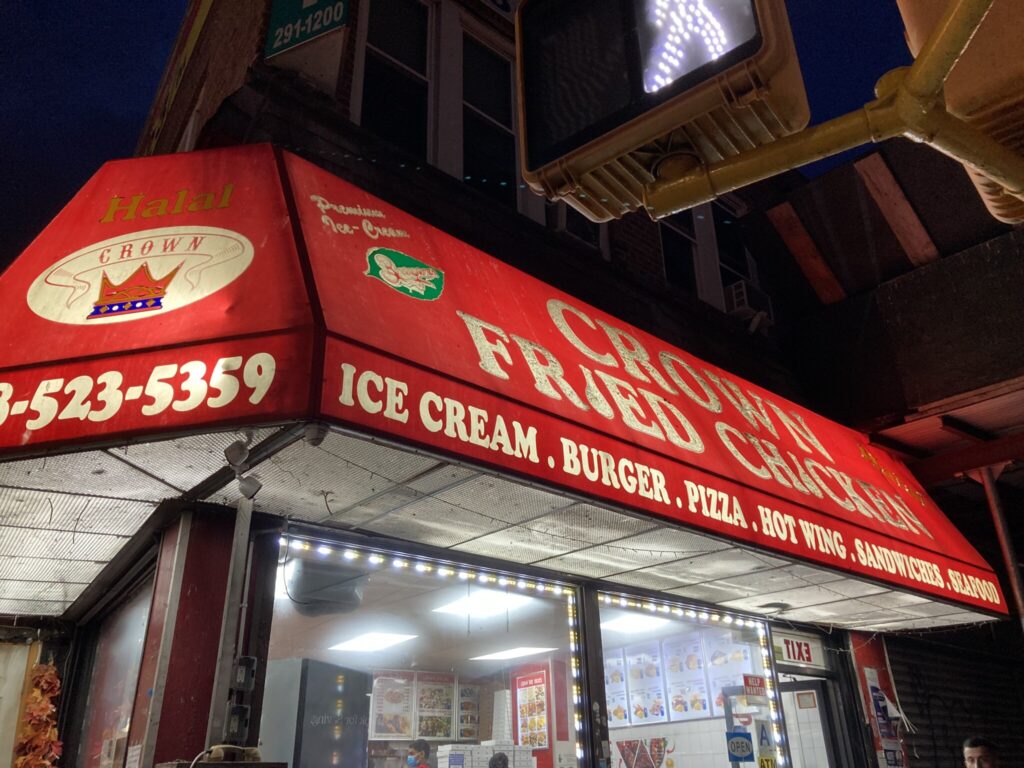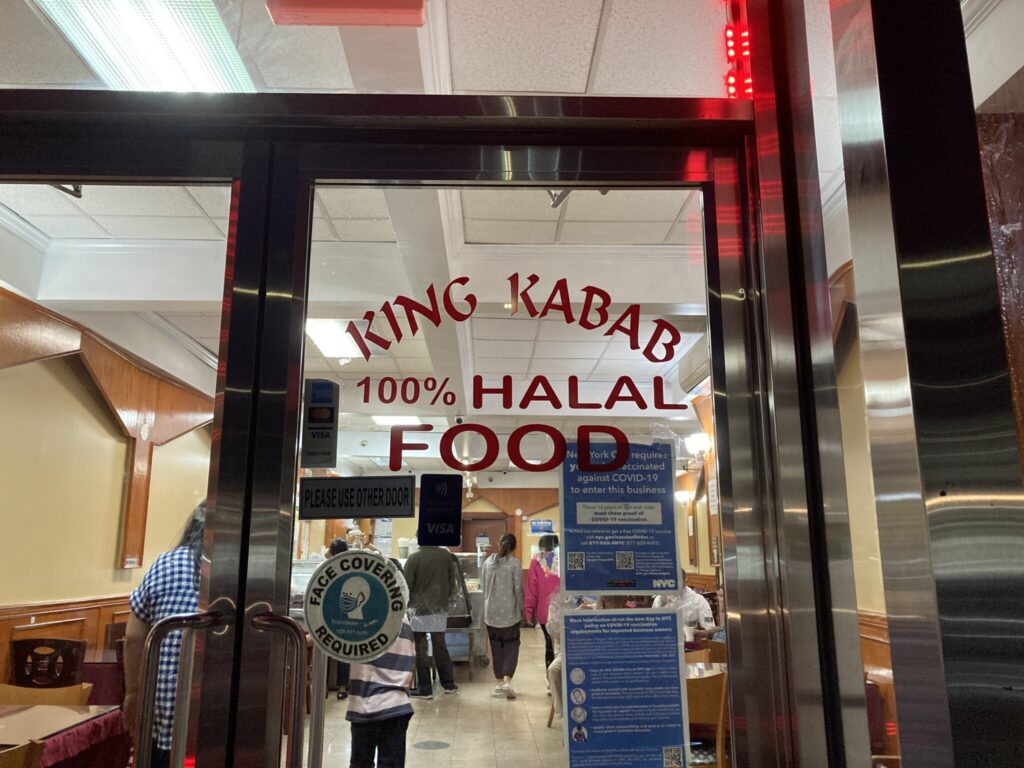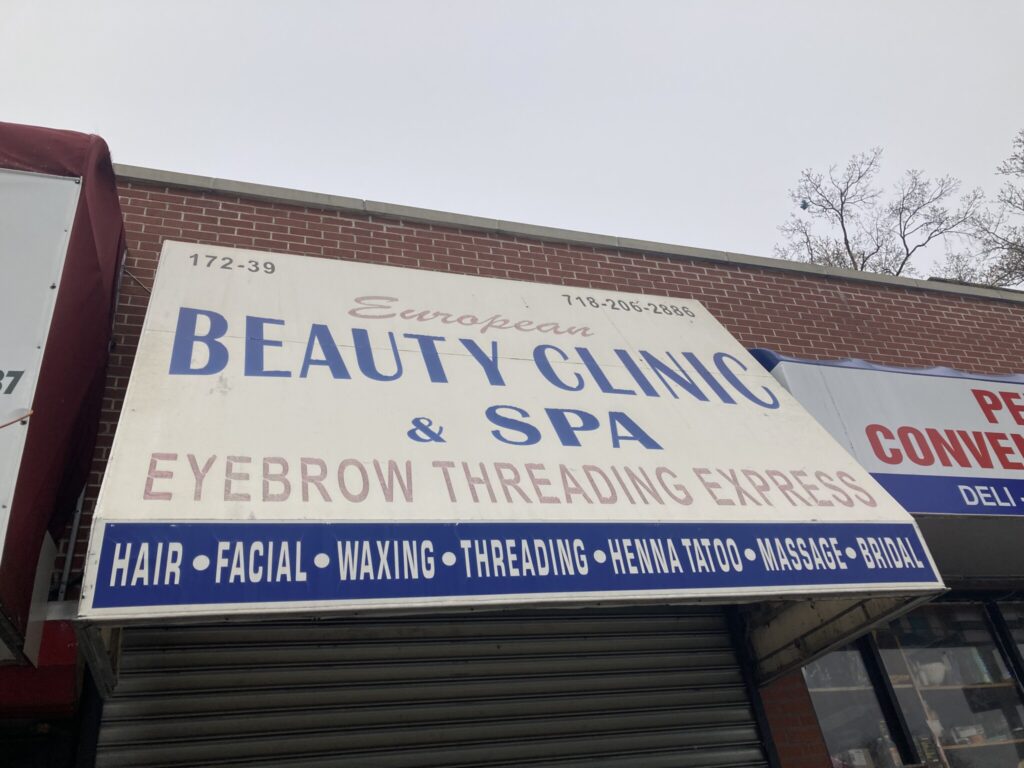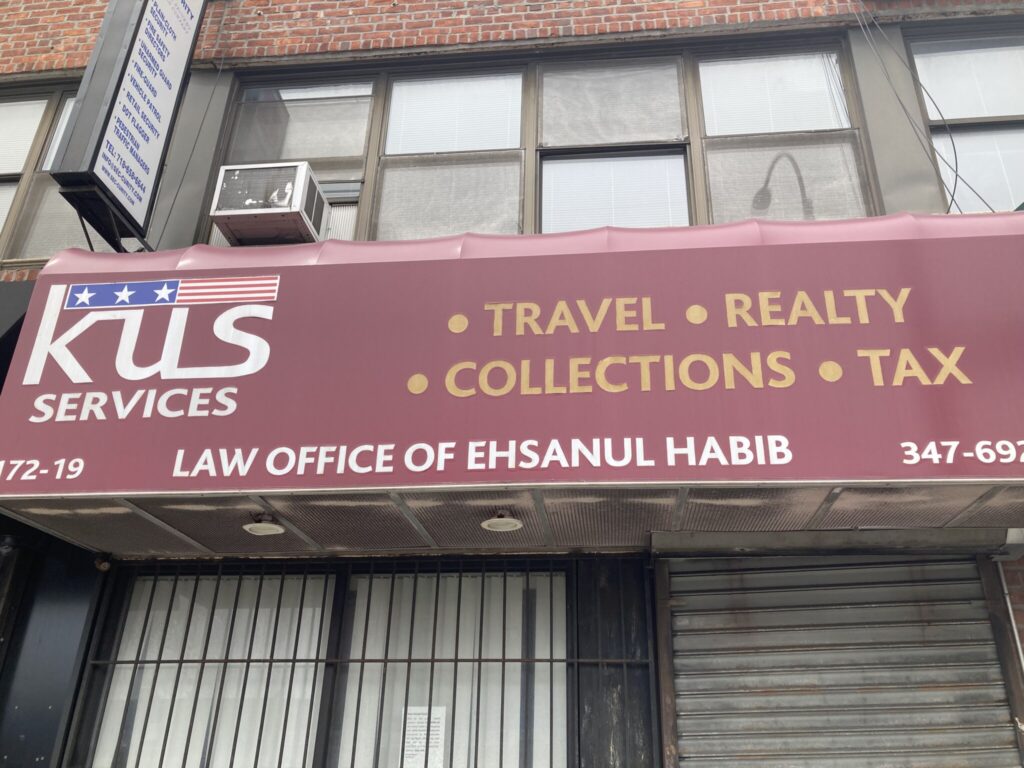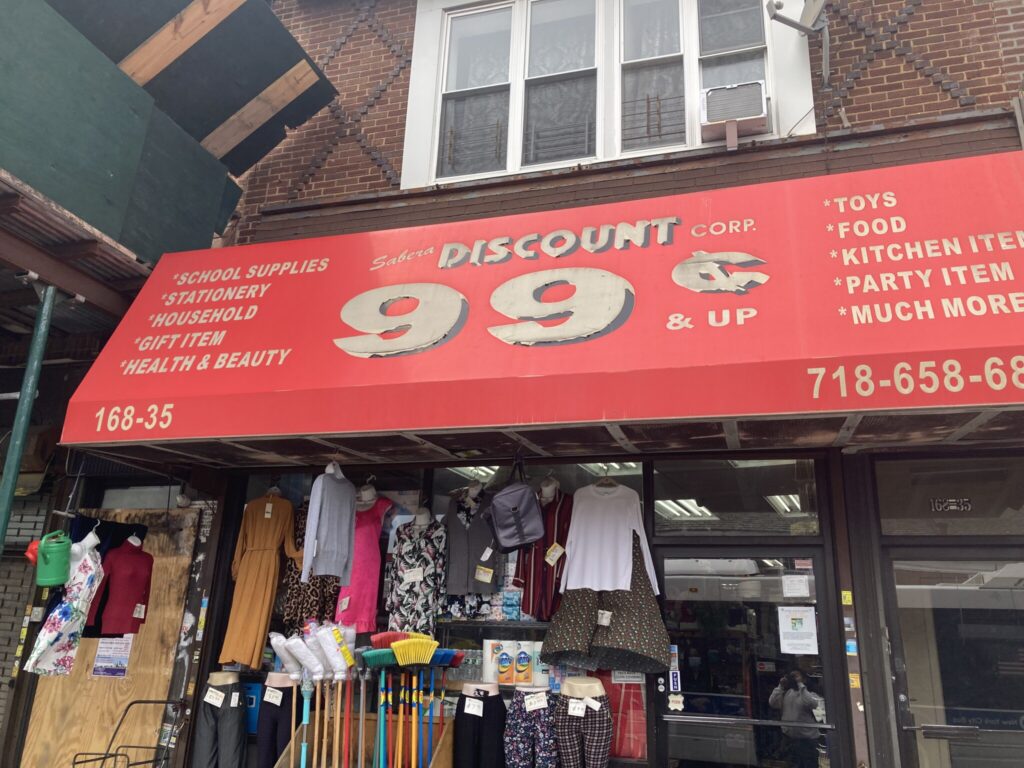
Jamaica, New York seems to be an epicenter of Bengalis and a mirror image of Dhaka, the capital city Bangladesh. Growing up in Dhaka until the age of 17, I feel a similar atmosphere and culture in Jamaica. With the solely Bangladeshi identifying population in New York City growing from 35,275 people in 2010 to 66,197 in 2010, it is no wonder why. A majority of the individuals in the area communicate in Bangla or in Spanish leading to many of the signs using words from those languages (either with English or non-English letters) to cater to each specific demographic. Additionally, a majority of the signs are contain an appeal to the dominant religion of the area-Islam- and contain many specific details to differentiate themselves to consumers.
From a majority of the signs, we can see that they do not only contain English words but words from Bangla or Spanish and even sometimes the letters used are from those languages. In one of the signs for dentist practitioners, we can see that the main heading is in English as “DENTIST” whereas there is a tiny section spelled out in Spanish “SE HABLA ESPANOL” which means Spanish Spoken. From this we can get an understanding that English is the dominant language in the area with Spanish still being prominent. In fact, with the population demographics of Hillcrest/Fresh Meadows being Hispanic with 21.1%, Black with 15.6%, white 27.1% and the majority with 30.9% identified as Asian according to a survey in 2019. With almost a quarter of the overall population being Hispanic, we can see that many stores and restaurants chose to appeal to that specific demographic by having loaned words from Spanish to English directly on signs like the restaurant and bar titled “NUEVO TEQUILAZO” which means new tequilas shot. Even though both establishments have a mixture of both English and Spanish in their signs, the dentistry highlights the English word of Dentist so as to attract any general customer that might be in need of dental assistance. However, the restaurant by having bolden and the largest sized word of Tequilazo, hopes to appeal to a more niche segment of customers who are especially looking for drinks and food relating to Hispanic culture.
The same strategy seems to have been applied by “GHOROA” which means home made in Bangla. By having the main headline be a word in Bangla, they are trying to appeal to the large South Asian community in the area so that they may directly know that they can expect to have the same kind of food as in their country when they enter the restaurant. Additionally, by having the subscript of “the taste of home” in English underneath, they are translating their name to non-bengali speakers so that they may give a sense that only fresh food is sold at their establishment.

Additionally, one of the dentistry establishment’s main section is in English while the subheading is fully in Bangla. However, this time, Bangla seems to be using the same English words above their section as if to provide a direct translation. This is probably due to the fact that a large proportion of Bangladeshis were born in Bangladesh and hence there are fewer Bangladeshi-Americans. In 2015, approximately 74% of Bangladeshis were natives from their land as compared to 37% of all residents in New York City. With the dominant region of birth for the immigrant population in the area being Latin America(76%) and Asia(19%), a large proportion of signs contain characters from languages in those regions as well so as to aid the prominent groups of non-native speakers of English.
As Courtney French, general manager at Jamaica Arts & Learning Centre says, “My neighbors are from everywhere. Living in Jamaica you can feel that the world can live together”. As the area has a large immigrant population from different nations and an almost even distribution between individuals identifying in different races, English is often utilized to break the barrier between such diverse cultures. That is why in most signs English is at the forefront while acknowledgement to different ethnic languages are provided through subheadings.
In the “PERFECT CONVENIENCE CORP.” we see no other language except English even though the area consists of people who speak multiple languages. As is the case “21st Century Cosmetic Dentistry” which does not seem to have any other language present except English. It seems that all providers of essential goods rely on English to communicate their services most likely due to how English is the mostly commonly used language in the US and hence forms a bridge between cultures to communicate required essentials of life.
However, the more brick and mortar stores like the “MARTIAL ARTS” training provider includes Chinese characters near far right and left of the sign even though English is at the forefront. This along with how the restaurants attempt to distinguish themselves from the rest by having names and words borrowed from their own languages show how they are trying to appeal to a specific consumer base who would be more convinced of the product if they could connect the type of dishes and name of the establishment.
Some signs also use religious text or borrowed words from scriptures to indicate the an associations with the specific followers of the religion. As in the example of “HALAL DYNASTY: CHINESE & MALAYSIAN RESTAURANT”, the inclusion of “halal” which stands for permissible in Islam is utilized to indicate that Muslims are some of their target demographics. Additionally, the inclusion of Chinese and Malaysian instead of borrowed Chinese or Malaysian words and by directly spelling out the kind of service they provide, they seem to be trying to highlighting cultures that are not as prominent in the area. The addition of the Arabic inscription of halal in a way can be seen as a way to legitimize an establishment’s claim of being halal due to how important it is for Muslims. In a nearby fast-food establishment we named, “Crown Friend Chicken” with the word “Halal” being repeated across its sign. The aspect of the food being halal seems to be more highlighted than the items being offered like pizza, burger etc. placed underneath the sign while the Halal word having a larger font and separate color of yellow. Additionally, in another establishment named “KING KABAB” we see the addition of “100% HALAL FOOD” at the entrance as way to ensure trust between incoming Muslim customers. The addition of the number in a way acts as a sort of guarantee on the kind of service they will be providing. Upon walking in the area, one can hear people converse in Bangla in almost every corner. With Bangladesh being one of seven countries in the Asia-Pacific region to be categorized as an Islamic country due to its large majority of Muslims, there is a large intersection of individuals with those identities Even though, in New York City it is estimated that 3% of the residents are Muslims, from the signs in Jamaica it can be seen that there is a large concentration of those who follow Islam. A reason for this might be due to how Jamaica is seems to be an epicenter for South Asian Muslims. Before the pandemic, it was reported that the largest accumulation of Muslims in the US for their took place in the playground of Thomas A. Edison High School in Jamaica for their Eid prayer. The large ensemble of Muslims in the area is reflected by many of the restaurants focusing on how their meat is halal.
In many of the signs we see a list of items being spelled out. In the “European BEAUTY CLINIC & SPA” sign we see the services being provided inside underneath the main title like the hair, facial, waxing, henna tattoo etc. Instead of awaiting a customer interested in a spa’s services, the variety of services they can expect at the store can be seen to be foretold in the sign. Again, in “KUS SERVICES: LAW OFFICE OF EHSANUL HABIB” we see the domains of consulting given to consumers bulleted like travel, realty, tax etc. along with the main name being underneath the section of an US flag. Similarly, more specification is given out on the type of products available instead of letting themselves being categorized as just a law consulting office which could have implied a broader spectrum of services. With the “Discount 99 cents & UP” store we see the trend being continued by the list of categories of goods available like kitchen items, party item and ending the list with “much more” along with the main title of the store. A majority of the signs seem to emphasize various quantities of goods available instead of just relying on their name to bring in customers. I believe this is because throughout the area there seems to be a lack of traditional chain stores like Starbucks, Target etc. and this fact is reflected by the large amounts of information in the local stores. As a large majority of the local stores do not have as high of a brand recognition as large conglomerates, it becomes harder for consumers to know what they can expect to see inside just by the store name. Additionally, as they are not well known for any particular good, they have the ability to not be tied down to a specific good like chairs. By offering more than one good or type of service available inside, they are trying to fill the needs of more consumer while also diversifying their streams of products and not specializing in a singular one.
References:
Asian American Federation. (2019). Profile of New York City’s Bangladeshi Americans. https://www.aafederation.org/wp-content/uploads/2020/12/2019bn.pdf
Beit Al Madis Islamic Center, Iqra Masjid Community and Tradition Inc., Islamic Cultural Center of North America, Masjid Aqsa mosque, The Mosque of Islamic Brotherhood & Muslim American Society(MAS).(2011). New York’s Diverse Muslim Community.
https://nyf.org/files/2019/08/NYF_Muslim_A.pdf
Census Reporter. (2020). NYC-Queens Community District 12—Jamaica, Hollis & St. Albans Puma, NY.
Chaudhry, S. (2020). Jamaica Rising. Destabilizing Queens. https://projects.newsdoc.org/destabilizingqueens/jamaica-rising/
Karim W. (2022). Jamaica, NY: A slice of Bangladesh away from it. The Daily Star.
NYU Furman Centre. (2020). NYU.https://furmancenter.org/neighborhoods/view/hillcrest-fresh-meadows
Pew Research Center. (2014). Religious composition of adults in the New York City metro area.
https://www.pewresearch.org/religion/religious-landscape-study/metro-area/new-york-city-metro-area/
Pew Research Center. (2017). Many countries favor specific religions, officially or unofficially.
